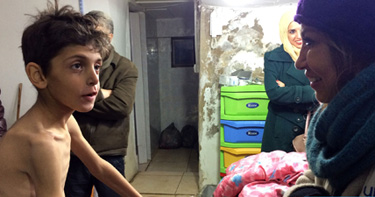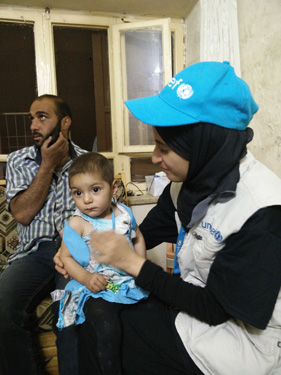Signs of recovery amid the siege in Madaya
2016-05-10
© UNICEF Syrian Arab Republic/2016 - A UNICEF staff member greets 8-year-old Mohammed. When the UNICEF team met him in January, he was malnourished and extremely weak. After being treated with therapeutic food, he is now stronger and has gone back to school.
By Shushan Meahtu
After several humanitarian aid convoys reached Madaya, residents of the besieged Syrian town are showing some signs of improvement. But limited access has left the makeshift hospital without professional health staff and supplies, while hundreds are still in need of urgent medical care.
MADAYA, Syrian Arab Republic/ HONG KONG, 10 May 2016 – Madaya, the Syrian town that was once the scene of shocking images of malnourished children, is showing small signs of recovery. Thanks to UNICEF’s support and the determination of health workers, the situation of malnutrition in Madaya is slowly improving.
But the restrictions imposed by the siege continue to deny medical access and evacuation of those children who need specialized treatment. For those in need of urgent medical care – some 1,300 people, including 92 children and their families – the situation remains desperate.
The most recent inter-agency humanitarian convoy to Madaya took place on 30 April 2016, and the UNICEF team visited the only makeshift hospital inside the town. Ill-equipped and underqualified to treat the high volume of patients, the staff pleaded for immediate medical evacuation of the critically ill. They also expressed fears that they will soon run out of nutritional supplies, given the extremely limited humanitarian access.
“Daily we are witnessing the deaths of people who are on the list for medical evacuation. Patients are dying, what can we do?”
Growing stronger
While visiting the hospital, UNICEF staff provided follow-up care for around 40 children who presented serious symptoms of malnutrition during the last mission to the town on 17 Feuary.
“Compared to the dire levels of malnutrition we saw in January and Feuary, the situation in Madaya has stabilized,” said UNICEF Nutrition Specialist Dr. Rajia Sharhan who, along with her colleague Nutrition Officer Dr. Houssam Baradee, participated in the mission.
“During the last two missions we found people barely surviving. Sadly, during our visit in January we also witnessed the death of a 16-year-old boy who was acutely malnourished, with medical complications. It was too late to save his life – the scene was hearteaking,” added Dr. Sharhan. “Now, the children are smiling, they look healthier and lively. Consultations at the hospital have become more organized.”
While visiting the hospital, UNICEF staff provided follow-up care for around 40 children who presented serious symptoms of malnutrition during the last mission to the town on 17 Feuary.
“Compared to the dire levels of malnutrition we saw in January and Feuary, the situation in Madaya has stabilized,” said UNICEF Nutrition Specialist Dr. Rajia Sharhan who, along with her colleague Nutrition Officer Dr. Houssam Baradee, participated in the mission.
“During the last two missions we found people barely surviving. Sadly, during our visit in January we also witnessed the death of a 16-year-old boy who was acutely malnourished, with medical complications. It was too late to save his life – the scene was hearteaking,” added Dr. Sharhan. “Now, the children are smiling, they look healthier and lively. Consultations at the hospital have become more organized.”

© UNICEF Syrian Arab Republic/2016 Mohammed sits with the UNICEF Syria Representative in January 2016. Just a few months ago, he was severely malnourished, and extremely weak and fragile.
Eight-year-old Mohammed is one of the children who continues to recover. Just a few months ago, he was seen in a video that went viral and ought the world’s attention to the severe malnutrition in Madaya. When the UNICEF team met him in January, Mohammed was extremely weak and fragile, with his rib cage protruding from his small body. Mohammed’s life has been saved thanks to the health team in Madaya who treated him with UNICEF therapeutic food. Mohammed is stronger now and has gone back to school. He proudly says he want to become a doctor.
Limar, the baby with huge, haunting eyes who was featured in a video that also went viral, was on the ink of death when she was ought to the makeshift hospital in January. She was suffering from acute malnutrition and had lost her appetite completely, her weak body unable to obtain vital nutrients from any of the food she consumed. Her condition was so critical that she would either die or potentially face permanent mental and physical damage. Thankfully, Limar received lifesaving treatment just in time, and she is now back on her feet and recovering. She will be able to lead a healthy life, but she still needs continued specialized medical care.
Devastating consequences of siege
Despite the improvements in child nutrition, the overall humanitarian situation in the town is still dire. Children continue to suffer from the devastating consequences of the restrictions imposed by the siege. Ehda, aged 8, sustained a shrapnel injury in her right eye in Feuary. She was not allowed to leave Madaya for treatment and loss of vision in the eye.
Other children are facing life-threatening conditions including renal failure, rheumatic fever, shrapnel wounds, liver and heart disease – conditions that require specialist treatment that is currently unavailable at the makeshift hospital. The UNICEF team identified 92 children who need urgent medical evacuation.
A young doctor who has not completed his medical studies, a dentist, and a veterinarian are the only three health professionals in Madaya. They are doing what they can to save lives, but they are working under extreme conditions, facing lines of patients to treat with insufficient medical supplies and equipment. “We have had to learn how to treat patients on the job, we have become specialists while still students,” the medical staff told UNICEF staff.

© UNICEF Syrian Arab Republic/2016 A UNICEF staff member holds Limar on her lap. Limar was suffering from malnutrition and was near death when she was ought to Madaya's makeshift hospital in January. She is now recovering and will be able to lead a healthy life.
With food and nutrition supplies arriving through aid convoys in the last three months, people are reported to be eating three meals a day once again. Unlike in previous months, people did not complain of hunger, but of the lack of food diversity in their diet. Some signs of life are returning to Madaya, but the shelves in the shops remain empty.
Urgent evacuation needed
Hospital staff reported that there were many cases of liver disease and other serious illnesses that cannot be treated, and a number of patients have died as a result. Prolonged starvation combined with the sudden introduction of food or the wrong type of food has itself led to medical complications, which require specialized and sustained care.
Only 125 patients were evacuated from Madaya during the last medevac on 20 April. Health centre staff, exhausted and overwhelmed by the number of people in need of lifesaving medical treatment, are simply unable to cope. They predict disastrous consequences, informing the UNICEF team that they have neither the resources, specialist expertise or the equipment and medicines required to treat people.
To maintain and continue the improvements in child nutrition and health, UNICEF and other aid agencies must have unconditional and sustained access to Madaya and other besieged towns. Access is needed not only to deliver lifesaving assistance, but to conduct assessments, provide medical treatment, support the evacuation of the critically ill and re-establish health and nutrition services.









